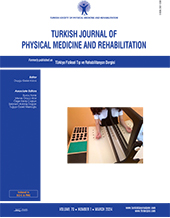Does fear of activity predict exercise capacity in patients with coronary artery disease in both sexes? A cross-sectional multicenter study
2 Department of Physical Medicine and Rehabilitation, Koç University School of Medicine, Istanbul, Türkiye
3 Department of Physical Medicine and Rehabilitation, University of Health Sciences, Gaziler Physical Therapy and Rehabilitation Training and Research Hospital, Ankara, Türkiye
4 Department of Physical Medicine and Rehabilitation, Medicine Faculty of Ondokuz Mayıs University, Samsun, Türkiye
5 Department of Physical Medicine and Rehabilitation, Medicine Faculty of Ankara University, Ankara, Türkiye
6 Department of Physical Medicine and Rehabilitation, Medicine Faculty of Pamukkale University, Denizli, Türkiye
7 Department of Physical Medicine and Rehabilitation, Medicine Faculty of Çukurova University, Adana, Türkiye
8 Department of Physical Medicine and Rehabilitation, Medicine Faculty of Ege University, İzmir, Türkiye
9 Department of Physical Medicine and Rehabilitation, University of Health Sciences, Ankara Dışkapı Yıldırım Beyazıt Training and Research Hospital, Ankara, Türkiye
10 Department of Physical Medicine and Rehabilitation, Medicine Faculty of Bülent Ecevit University, Zonguldak, Türkiye
11 Department of Physical Medicine and Rehabilitation, Medicine Faculty of Süleyman Demirel University, Isparta, Türkiye
12 Department of Physical Medicine and Rehabilitation, University of Health Sciences, Ankara Training and Research Hospital, Ankara, Türkiye
13 Department of Physical Medicine and Rehabilitation, Medicine Faculty of Trakya University, Edirne, Türkiye
14 Department of Physical Medicine and Rehabilitation, University of Health Sciences, Gülhane School of Medicine, Gaziler Physical Medicine and Rehabilitation Training and Research Hospital, Ankara, Türkiye
15 Department of Physical Therapy and Rehabilitation, Health Sciences University, Kayseri Training and Research Hospital, Kayseri, Türkiye DOI : 10.5606/tftrd.2024.12956 Objectives: This study aimed to identify whether fear of activity predicts exercise capacity in patients with coronary artery disease (CAD) and whether there is a difference between sexes regarding this relationship.
Patients and methods: One hundred ninety-seven patients (145 males, 52 females; mean age: 56.3±10.8 years; range, 22 to 80 years) with a diagnosis of CAD or cardiac event in the previous one to 60 months were enrolled in this cross-sectional multicenter study between November 2015 and February 2017. Demographic and clinical features were recorded. Fear of activity was assessed by the fear of activity scale in patients with CAD (FactCAD). A 6-min walk test was used to assess exercise capacity.
Results: Female participants were older, less educated, and less employed (p=0.045, p=0.048, and p<0.001, respectively) than males. Prevalence of myocardial infarction was higher in males. Comorbidities were higher in females. Multiple linear regression predicted 6-min walk distance (6MWD) based on FactCAD, sex, and education level with an r-squared of 0.321 (p<0.001). Fear of activity had an effect on walking distance in males (each additional score of FactCAD predicts a decrease of 1.3 m in 6MWD), together with disease duration, presence of chronic pulmonary disease, and low back pain, whereas fear of activity was not a predicting factor on walking distance in females. Age, education, and presence of angina predicted 6MWD in females.
Conclusion: This study emphasizes that fear of activity is one of the predictors of 6MWD in males with CAD, and its assessment is recommended as a possible barrier to rehabilitation.
Keywords : 6-min walk test, angina, coronary artery disease, exercise capacity, fear of activity, sex
















